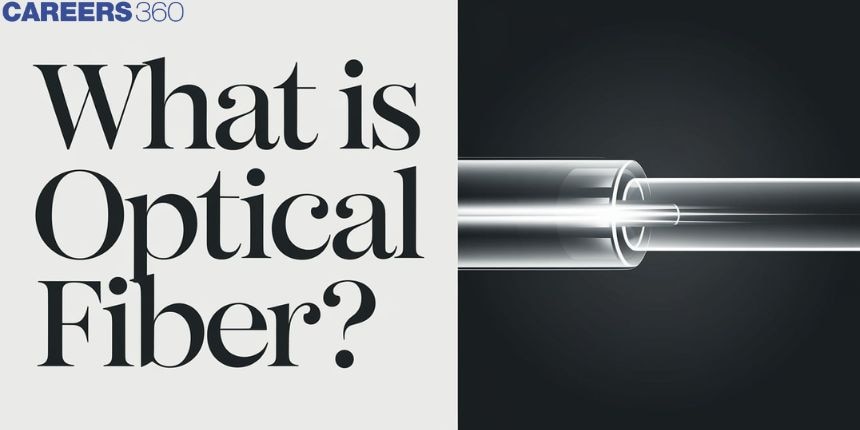What is Optical Fiber - Definition, Principle, Work, Advantages, FAQs
An optical fibre is a thin, flexible, and transparent wire made of glass (silica) or plastic. It is used to carry light signals from one place to another very quickly. Each fibre is about as thin as a strand of human hair. Optical fibres are used for high-speed communication, such as the internet, telephone, and cable TV. They are better than metal wires because they transfer data faster and lose very little signal during transmission. Light travels through the fibre by total internal reflection, even when the fibre bends. In this topic, You will learn about what is Optical fibre, types of optical fibres, principle of optical fibre, construction of optical fibre and their advantages.
This Story also Contains
- What is Optical Fibre?
- Principle of Optical Fibre
- Types of optical fibre
- Construction of Optical Fibre
- Work of Optical Fibre
- Advantages of Optical Fibre

Also read -
What is Optical Fibre?
An optical fibre is a thin, flexible strand of glass or plastic that carries light signals from one place to another. It works on the principle of total internal reflection, where light bounces inside the fibre without escaping, even when the fibre bends.
Optical fibres are used to transmit data, images, and messages at very high speed over long distances.

Principle of Optical Fibre
The working principle of an optical fibre is based on Total Internal Reflection (TIR).
When light travels from a denser medium (core) to a rarer medium (cladding) at an angle greater than the critical angle, it is completely reflected back into the core instead of passing out. This repeated reflection allows light to travel through the fibre, even if it bends.
Types of optical fibre
The following is the classification based on the refractive index:
- Step Index Fibers have a single uniform index of refraction and are made up of a core and cladding.
- Graded Index Fibers: As the radial distance from the fibre axis rises, the refractive index of the optical fibre falls.
The following is a categorization based on the materials used:
- Plastic Optical Fibers: For light transmission, polymethylmethacrylate is employed as the core material.
- Glass Fibers: It is made up of ultra-fine glass fibres.
The following is a classification based on the mode of light propagation:
- Single-Mode Fibers: These fibres are used to transmit signals over vast distances.
- Multimode Fibers: These fibres are used to transmit signals across short distances.
The core's refractive index and mode of propagation are used to create four different types of optic fibres:
- Single-mode fibres with a step-index
- Single-mode fibres with a graded-index
- Multimode fibres step-index
- Multimode fibres with a graded-index
Construction of Optical Fibre
An optical fibre is made up of three main parts:
1. Core:
- The inner glass or plastic part through which the light travels.
- It has a high refractive index to keep the light inside.
2. Cladding:
- A covering layer around the core made of glass or plastic with a lower refractive index.
- It helps in total internal reflection, preventing light from escaping.
3. Protective Coating (or Jacket):
- The outer layer made of plastic.
- Protects the fibre from moisture, damage, and bending.
Work of Optical Fibre
Total internal reflection is used to operate the optical fibre. Light beams can transport a large quantity of data, but they travel in straight lines, which is an issue. So, unless we have a long straight wire with no bends, making use of this advantage will be time-consuming. Optical wires, on the other hand, bend all light rays inwards (using TIR). Light rays travel indefinitely, bouncing off the walls of optical fibres and transmitting data end to end. Although light signals degrade with time depending on the purity of the material employed, the loss is substantially lower than with metal cables.
A Fiber Optic Relay System is made up of the following components:
- The Transmitter generates light signals and encodes them for transmission.
- The Optical Fiber is the medium used to transfer light pulses (signal).
- The Optical Receiver - This device receives and decodes sent light pulses (signals) to make them usable.
- An optical regenerator is required for long-distance data transmission.
Also Read:
Advantages of Optical Fibre
- Cost-effective and economical
- Non-flammable and thin
- Power usage is reduced.
- Signal degradation is reduced.
- Lightweight and flexible
Also check-
- NCERT Exemplar Class 11th Physics Solutions
- NCERT Exemplar Class 12th Physics Solutions
- NCERT Exemplar Solutions for All Subjects
NCERT Physics Notes:
Frequently Asked Questions (FAQs)
Optical fibres are made from either silica or multi-component glass.
Silica is ideal for fabrication since it has perfect flexibility until it reaches its breaking point.
The optical fibre communication system is based on the principle of total internal reflection.
The following are the reasons that cause optical power attenuation in fibre:
Waveguide Absorption Scattering Effect
The following are some of the reasons why plastic-clad silica fibre optic cables are difficult to use:
Organic solvents do not dissolve the fibres.
Bonding becomes a challenge.
Because of the cladding's extreme flexibility, connecting it becomes challenging.
Optical fibre cable has the following advantages:
The data security is outstanding.
Interference will have no effect on it.
The optical fibre's bandwidth is 900 THz.
The core is the light-carrying portion of the optical fibre.
Optical fibre communication has a number of advantages, including:
Signal degradation is reduced.
Non-flammable and thin
Cost-effective and economical
Power usage is reduced.